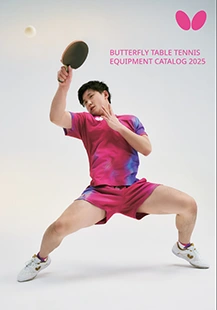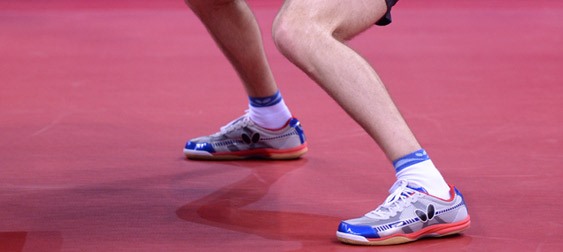Searching for the Right Position
Butterfly Table Tennis Coaching
by Han Xiao
Footwork is one of the most difficult skills to master in table tennis. Most players know how to perform basic lateral footwork to get to a position where they can hit the ball, and some players can also effectively move front and back. Most intermediate players, however, don’t have good anticipation and are not constantly looking for the correct position before they are forced to move to the ball.
Moving Between Shots
The first step to improving anticipation and being able to always find the right position is constantly moving between shots. Like many other sports where “moving without the ball” is a key part to effective play, in table tennis moving when you aren’t forced to gives you a much better chance to be in position to hit a quality shot when the ball finally arrives.
Where should you be moving? If nothing else, moving or bouncing in place will help you start moving when you really need to due to inertia. Ideally, you want to be moving somewhere close to neutral position. I’ve written a bit about neutral position before in this column, but the idea of neutral position is to be able to cover all the angles that the opponent can easily hit to from their ball striking position. This means that neutral position is related to where you hit the ball. If you hit the ball wide to the forehand, neutral position now skews more to your own forehand side. Likewise if you hit the ball wide to the backhand, neutral position is somewhere close to your backhand corner.
If you are playing in a match, you can adjust your footwork to account for the opponent’s patterns and tendencies. For example, if the opponent has forehand loops down the line every time when stepping around, adjust your positioning to account for this tendency until your opponent changes his or her play.
Note that the absolute worst thing you can do is try to guess at the last minute where the ball is going. This is not the correct way to anticipate and should only be used as a last resort when the opponent seemingly has an easy kill. The reasoning is that when you move quickly in one direction or another, it is nearly impossible to change direction as well as your body position at the very last minute if you guess wrong. It is in fact more efficient to not be moving at all than to be moving in the wrong direction. As a result, when moving between shots, it is important to move as early as possible to a good position, and then to bounce in place and watch the ball as the opponent hits the ball in order to be ready to make your next move.
Benefits
The biggest benefit of moving between shots is that you will be able to play far more aggressively without assuming more risk, especially with the forehand. Most players miss forehand attacks mainly due to poor positioning and poor footwork. When combined with the desire to hit a high quality shot such as a strong forehand topspin, this leads to wild swings, mishits, and many unforced errors overall. With more effective movement between shots, however, you will find that it becomes much easier to play aggressively. For example, if you push the ball deep and the opponent has been looping soft crosscourt against this type of push, you can quickly anticipate and move into good position, not only laterally, but a half step back as well. After the opponent loops the ball slow, you are already close to the right position to counterloop the ball, rather than being close to the table and attempting an overly aggressive counterattack off the bounce. With only a small adjustment, it becomes very easy to counterattack without a great deal of risk. You will also find that when attacking, it will be much more difficult for the opponent to block you out of position. Additionally, moving well between shots will greatly improve your play away from the table, regardless of attack or defense, since there is much more ground to cover when you are playing far from the table and you need to be able to anticipate and start in a good position.
Ways to Practice Moving Between Shots
Other than focusing on moving between shots in regular drills, there are some other ways to specifically practice this skill. One thing you can practice is instead of just practicing counterlooping forehand to forehand during training, practice counterlooping anywhere on the table with your partner. The emphasis should not be on power, but moving into good positions to be able to continue counterlooping without losing balance or control. This drill requires you to pay special attention to where you are looping the ball and quickly assessing where neutral position should be and moving there before the opponent makes contact with the ball.
Drills that have some random element that force you to use only your forehand are also excellent drills for developing footwork, but can be very difficult. A simple way to begin is to have your partner block to the backhand half of your side while you step around and loop, focusing on adjusting your positioning after every ball. If you don’t move and adjust your body position after every shot, you will struggle to cover the balls closer to the middle of the table. As you become more familiar with the drill, expand the area of the table you can cover to two thirds of the table. Another more difficult variation is a fixed drill where your partner only blocks to your backhand corner very slowly and you step around to loop with the forehand. The catch is that after every loop, you have to move back to neutral position as if you didn’t know where the next ball is going. This is a very difficult drill but for advanced players can really help you train moving back to neutral position after every shot and having the confidence in your footwork to play aggressively.
There are many other ways to practice this, and as I mentioned before focusing on this aspect of your footwork in other drills is always helpful since a lot of it is simply staying focused, not being lazy, and willing yourself to move all the time. Doing physical training such as jump rope can also help your strength and quickness, improving your ability to constantly stay on your toes and move between shots. It all depends on how committed you are and how much you want to improve this aspect of your game.
























